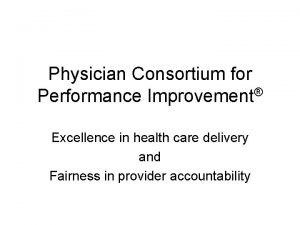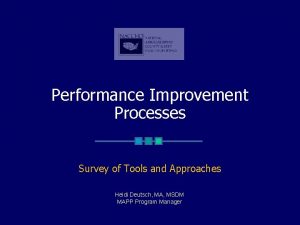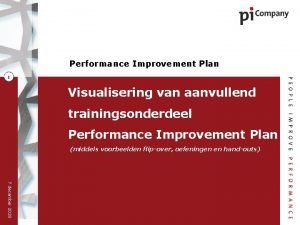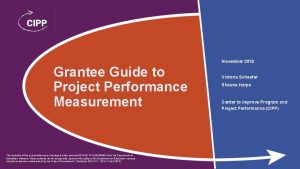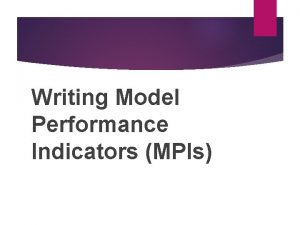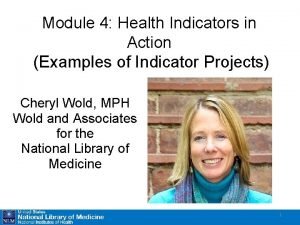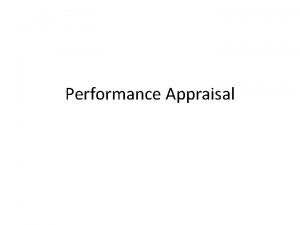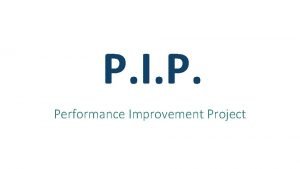Performance Improvement Project PIP Clinic Topic Selection Indicators


















































- Slides: 50

Performance Improvement Project (PIP) Clinic: Topic Selection, Indicators, Interventions June 21, 2018 Amy Mc. Curry Schwartz, Esq. , MHSA EQRO Consultant Behavioral Health Concepts, Inc. amy. mccurry@bhceqro. com

OMB Approval No. 0938 -0786 EQR PROTOCOL 3: VALIDATING PERFORMANCE IMPROVEMENT PROJECTS (PIPs) A Mandatory Protocol for External Quality Reviews (EQR) 2

CMS Protocol: Validating Performance Improvement Projects 10 Protocol Steps: 1) Select the study topic(s) 2) Define the study question(s) 3) Use a Representative and Generalizable study population 4) Select the study variable(s) 5) Use sound sampling techniques 3

CMS Protocol: Validating Performance Improvement Projects 10 Protocol Steps Continued: 6) Reliably collect data 7) Analyze data and interpret study results 8) Implement intervention/improvement strategies 9) Plan for “real” improvement 10) Achieve sustained improvement 4

Step 1: Select the study topic(s) Look for topics that: Affect a significant portion of consumers Have a potentially significant impact on consumer health, functional status or satisfaction Reflect high-volume or high-risk conditions of the population served 5

Step 1: Select the study topic(s) Do a thorough data review before beginning the PIP County specific data Review local data linked to your challenge/problem Review system procedures and process linked to your challenge/problem National data Helpful background, benchmarks and possible interventions SAMHSA, NIDA, NIMH, NIATX, AHRQ, NCQA, ASAM, NSDUH, etc

Assess Ask: Do we know if this is problem nationally? What are the national averages for this problem/issue/condition? Is there a norm we are not meeting? Is this a problem for our county?

Step 1: Select the study topic(s) Data sources that may help: County eligibility database County encounter/claims data County performance on standardized measures External data – Medicaid FFS, other health plans, local or national public health reports (be sure to show this data has a direct correlation to the County’s population) 8

Step 1: Select the study topic(s)- Facts Identify a problem area or opportunity for improvement in treatment or process, but do not take it “to the bank” without first reviewing your facts and data Include information from clients, families, staff and community partners Client, families, community partner and staff input should be obtained on problem What do they see as the barriers to better care? Why do they think the problem is happening? What ideas do they have to fix it?

Assess Ask: Do we have a way to measure that? What data do we have that would show us if there is in fact an issue? Do we know if our issue is “out of whack” with other similarly sized counties?

Assess If the MHP or DMC-ODS feels there is an issue, a baseline measurement must be established.

Plan The MHP or DMC- ODS should gather input from stakeholders to explore solutions to the problem. What Can How barriers exist? the County effect those barriers? will the MHP/ DMC-ODS measure their effect?

Questions

Step 2: Define the Study Question(s) Make the Question: Obvious Simple Answerable 14

Step 2: Define the Study Question(s) State the Question in a way that: Supports the ability to determine whether the intervention has a measurable impact for a clearly defined population 15

Step 2: Define the Study Question(s) Vague Study Question Example: An “implied” study question, or “Is a mail intervention adequate to improve medication adherence over time? ” 16

Step 2: Define the Study Question(s): Clearer Study Question Example: “Will providing educational materials to providers and members increase the number and percentage of consumers who participate in a medication clinic, and decrease the number and percentage of consumers who use crisis services? ” 17

Step 2: Define the Study Question(s): Clearer Study Question Example: “Does creating a Care Coordination Team with strategies to engage and provide timely access to outpatient services increase engagement and mental health treatment and increase overall client satisfaction? ”

Step 2: Define the Study Question(s): This step is critical because it sets the framework for data collection and analysis of results So take the time to develop a strong study question! 19

The BEST PIPs have…. Knowledge of what might have changed in your environment to contribute to or improve the problem (examples, opening or closing problems due to budget changes or new medications to help improve recovery for specific SUDs or diagnoses) A clear study question based on thorough data collection and analysis of the problem and potential causes

Questions

Step 4: Select the Study Indicator(s) A study indicator is: A measurable characteristic, quality, trait, or attribute of a particular individual, object, or situation being studied.

Step 4: Select the Study Indicator(s) Criteria Each PIP should have one or more measured indicators to track performance and improvement over a specific period of time. All measured indicators should be: Objective; and Clearly defined; and Based on current clinical knowledge or health services research; and Enrollee outcomes (e. g. health or functional status, enrollee satisfaction); or a valid indicator of these outcomes.

Step 4: Select the Study Indicator(s) The number and complexity of indicators (measures) may vary depending on: The Study Question(s); The complexity of existing practice guidelines for a clinical condition; and Availability of data and resources to gather data

Step 4: Select the Study Indicator(s) Indicators may be quantitative or qualitative and continuous or discrete. Discrete or categorical indicators have a limited number of possible categories An individual has/has not attended medication support in the last 6 months.

Step 4: Select the Study Indicator(s) Continuous indicators have unlimited possible values within the limits of the indicator range ANSA or CANSA score # of appointments attended Data collected on a continuous indicator such as # of appointments attended can be used for a discrete indicator (e. g. a client attended at least one appointment in the past 3 months)

Step 4: Select the Study Indicator(s) Study Indicator “tips”: The study indicator should be objective and clearly defined The indicator must be “measurable” – do you have the necessary data (or can you get it)? Use an existing, relevant health care guideline to develop the study indicator Use an existing indicator generally accepted in the health care community (ex. HEDIS; Clinical Practice Guidelines…) 27

Step 4: Select Study Indicator(s) Potential Sources of Supporting Information o o o Clinical and non-clinical practice guidelines o http: //www. psychiatry. org/practice/clinical-practice-guidelines o http: //www. cdc. gov/chronicdisease/resources/guidelines. htm Administrative Data o Claims data o Enrollment files Medical Records

Step 4: Select Study Indicator(s) Examples of measures currently existing within the public health community or managed care industry include: NCQA Healthcare Effectiveness Data Information Set (HEDIS) www. ncqa. org Measures developed by CMS and AHRQ (Pediatric or Adult Core Measures) www. ahrq. gov

Example of Study Indicators If goal is engagement/participation in medication clinic: Indicators“Consumers enrolled in medication clinic with <2 crisis visits/calls in a 6 month period. ” “Consumers enrolled in medication clinic with attendance at clinic >4 times in a 6 month period. ” “Consumers enrolled in medication clinic with attendance at clinic 6 times in a 6 month period and 0 crisis visits. " 30

Example of Study Indicators If goal is: More participation in treatment Indicator – “On follow up visit, clinician reported the consumer was engaged in treatment and willing to work towards treatment goals. ” If goal is: More ability to recall what client was to accomplish before the next visit Indicator – “Consumer was able to accomplish 1 or more next steps in their treatment plan by their return visit”. If goal is: Consumer satisfaction Indicator – “Pre and post satisfaction testing”

Questions

Connecting Interventions to Indicators Interventions should not focus on procedures, but on consumers.

Step 8: Implement Intervention and Improvement Strategies Interventions should: Relate to causes/barriers identified through data analysis Be culturally and linguistically appropriate Be “implementable” system-wide Not be “one time” efforts 34

Step 8: Implement Intervention and Improvement Strategies Topic: Decrease no-show rate Interventions: Reminder calls (standardized) Create a more welcoming environment Incentivize attendance

Step 8: Implement Intervention and Improvement Strategies Topic: Decrease no-show rate Interventions: Scheduling to accommodate public transportation times for clients using public transportation Help transport clients to their medication support appointments who are severely disabled.

Step 8: Implement Intervention and Improvement Strategies Topic: Improve access and retention Interventions: Implemented an integrated walk-in screening tool at one adult behavioral health clinic To improve the accurate identification of co-occurring diagnoses and to provide “right size” services to consumers from the start. One provider contacts each client

Step 8: Implement Intervention and Improvement Strategies An improvement strategy is an intervention designed to change behavior at an institutional, practitioner, or beneficiary level. Real, sustained improvement results from a continuous cycle of measuring performance and implementing system-wide improvements. (Plan, Do, Check, Act) 38

Questions

What makes a PIP successful? Meeting the Requirements of EQRO Submit a completed submission tool Use data to identify an issue and measure success Use of stakeholder input Measure early and often

PIP Ratings Active and Ongoing Baseline established on at least some of the indicators and at least some interventions started. Any Baseline establishedhave on at least some of the indicators and at least some combination of these will be acceptable. interventions have started. Any This WILL ofbe rated. combination these will be acceptable. This WILL be rated. Completed In the past 12 months or since the prior EQR. This WILL be rated.

PIP Ratings Concept Only, Not Yet Active Inactive, Developed in a Prior Year Submission Determined Not to be a PIP This is an opportunity to provide TA step-by-step and help the MHP/DMC-ODS move this towards an active PIP. Baseline may have been done, but interventions have not been started. This will NOT be rated. Rated in a prior year and not rated this year. For example: If a new intervention was not introduced in the current year, a PIP would be considered inactive. These will NOT be rated. Use this category when the write-up contains a lack of plan, data, or indication where the County will get their data, and the County has not implemented anything.

What makes a PIP successful? Potential to produce good results Implemented as planned Positive change occurs Positive change is sustained over time Initiative becomes an ongoing part of continuous quality approach to care

PIP Scoring Met Partially Met Not Met Each MET element = 2 points Each PARTIALLY MET element = 1 point The MET and Partially MET elements are divided by the Total Applicable Elements to. 44


PIP Scoring The MET and Partially MET elements are divided by the Total Applicable Elements to arrive at a score. (# MET * 2) + (# Partially MET) (# of Applicable Elements *2) 46


PIP Scoring The score is a reflection of the EQRO’s confidence in the PIP’s ability to show improvement (reach the goals). The score is NOT a rate of completion alone. 48

Contact Information PIP Technical Assistance is available from your assigned Quality Reviewer Amy Mc. Curry Schwartz, Esq. , MHSA amy. mccurry@bhceqro. com (855) 385 -3776 x 103

Questions
 Integrating metrics within the software process
Integrating metrics within the software process Pip project management
Pip project management Performance improvement plan examples
Performance improvement plan examples Physician consortium for performance improvement
Physician consortium for performance improvement Performance improvement survey
Performance improvement survey Pip template shrm
Pip template shrm Human performance improvement principles
Human performance improvement principles Housekeeping appraisal comments
Housekeeping appraisal comments Questioning attitude human performance
Questioning attitude human performance Reflector big five personality oefenen
Reflector big five personality oefenen Call center performance improvement plan template
Call center performance improvement plan template Treasury performance metrics
Treasury performance metrics Model performance indicators wida
Model performance indicators wida Payroll kpi template
Payroll kpi template Revenue cycle kpi
Revenue cycle kpi Abet performance indicators
Abet performance indicators Corporate social responsibility kpi examples
Corporate social responsibility kpi examples Sports and entertainment marketing performance indicators
Sports and entertainment marketing performance indicators Key performance indicators for capacity building
Key performance indicators for capacity building Model performance indicators
Model performance indicators Key performance indicators for shipping industry
Key performance indicators for shipping industry Sample kpi for project engineer
Sample kpi for project engineer Paulo magina
Paulo magina Performance monitoring and coaching form template editable
Performance monitoring and coaching form template editable Key performance indicators for lecturers
Key performance indicators for lecturers Academic performance indicators
Academic performance indicators What is wida standards
What is wida standards Unity and coherence
Unity and coherence Narrow down topic
Narrow down topic Group 4 project ib
Group 4 project ib The allied health profession service improvement project
The allied health profession service improvement project The allied health profession service improvement project
The allied health profession service improvement project Balancing selection vs stabilizing selection
Balancing selection vs stabilizing selection Similarities
Similarities K selection r selection
K selection r selection Natural selection vs artificial selection
Natural selection vs artificial selection Artificial selection vs natural selection
Artificial selection vs natural selection Naturual selection
Naturual selection Clumped dispersion
Clumped dispersion Natural selection vs artificial selection
Natural selection vs artificial selection Two way selection and multiway selection
Two way selection and multiway selection Two way selection and multiway selection in c
Two way selection and multiway selection in c Mass selection and pure line selection
Mass selection and pure line selection Boston police
Boston police Topic 7 economic performance and challenges
Topic 7 economic performance and challenges Objectives of performance appraisal
Objectives of performance appraisal Nyc.gov/pip
Nyc.gov/pip Verizon pip network
Verizon pip network Abdukcija palca
Abdukcija palca Cvp normal range
Cvp normal range Servo pressure on hfjv
Servo pressure on hfjv



